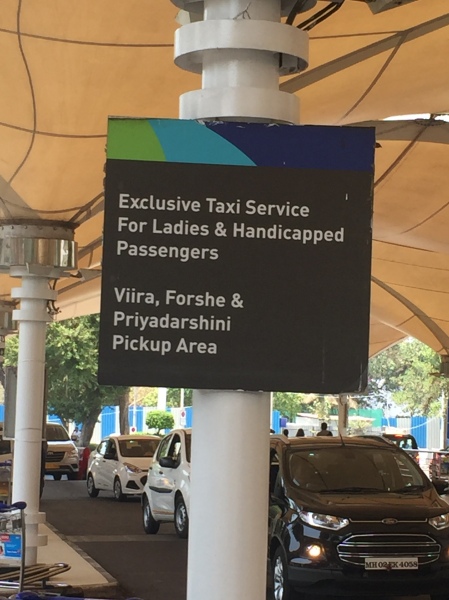15 April 2017
Mumbai hits me straight between the eyes. As I walk out of the airport, humidity envelops me in its sweaty embrace leaving no room for doubt that I am now in the Tropics. Cruising down Marine Drive – the three kilometre corniche which follows the natural curve of the bay into south Mumbai – I am mesmerised by the sight of the glittering Arabian Sea to one side, and the high-rise skyline of the thriving financial centre to the other. Tangible energy pervades every part of the city through which we pass. Delhi is hot and chaotic to be sure – but it’s nothing like this. Bombay – as many Indians still call it – is a teeming, urban jumble of ceaseless noise, traffic and people: it may lack the history of its Rajasthan counterpart, where tombs and forts lurk round every corner – and it certainly has far fewer green spaces – but you can feel straightaway that this is a place where things get done.
Mumbai works hard and plays hard. It has a population of 20 million, and although estimates vary, probably nearly half live in slums. These were of course famously depicted in Slumdog Millionaire – set in the city’s Dharavi which is the largest slum in Asia – and the film’s popularity has spawned an industry of “slum tours”. Although I feel instinctively averse to “poverty tourism” it does provide a partial solution to one of the biggest dilemmas faced by foreign visitors to India: whether or not to donate money to the numerous beggars who regularly approach. Resisting the seraphic little children is particularly difficult for most, but since many of them are victims of trafficking, giving alms really only serves to perpetuate the problem. So it’s good to learn that the “slum tours” donate 80% of their profits to charities tackling poverty at its root. And the work ethic of the Mumbaikar is as evident in the slums as anywhere else: their internal economies – especially derived from industries like recycling – make a significant contribution to economic growth.
But this is nothing if not a city of contrasts and the bedfellow of extreme poverty is extraordinary prosperity: Mumbai is an immensely wealthy place and the prime embodiment of that is the Taj Mahal hotel, which was built by the original Tata patriarch in the early 1900s after he was refused entry to another Bombay hotel on the grounds that he was non-white. This iconic landmark facing the sea is now as much a tourist attraction and favoured setting for upscale Mumbaikars to “be seen” in, as it is a bed for the night, and the stunning interior is a paean to Mammon, boasting vast lobbies, glitzy bars, restaurants and internal pools surrounded by cabanas, the whole place redolent of the most opulent hotels on the Las Vegas strip, albeit with far greater heritage, authenticity and an indomitable sense of style and spirit.
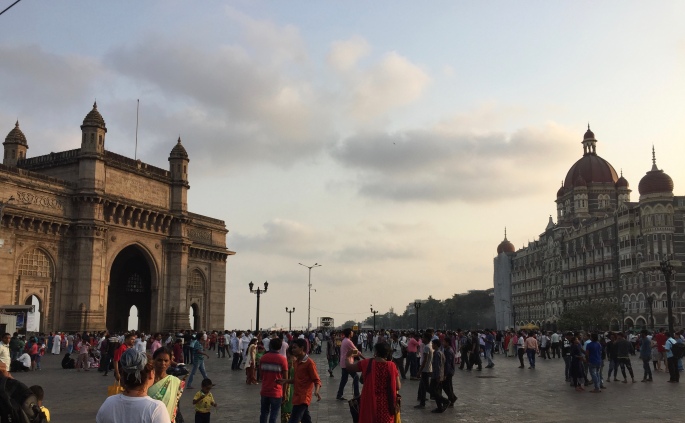
However, I am not staying at the Taj. Instead, I am very fortunate to have been found lodgings in the Royal Bombay Yacht Club (RBYC) in the central southern district of Coloba. The RBYC sits a stone’s throw from Gateway of India, the vast arch which dominates the port side opposite the Taj (it was through here that the last British occupiers symbolically sailed away in 1948) and is one of the prime examples of colonial architecture in Mumbai. It’s an extraordinary place, a fusion of Hogwarts and the Ritz hotel where turrets, spiral staircases and long, tiled corridors co-exist with excellent service, huge bedroom suites and fine dining. Breakfast is taken on a long, thin internal verandah, wood-panelled with arched stained glass windows and overlooking a sub-tropical garden of lush green palms (pictured below). It is a stunning place to start the day.
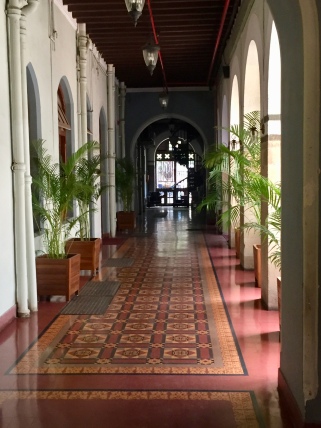
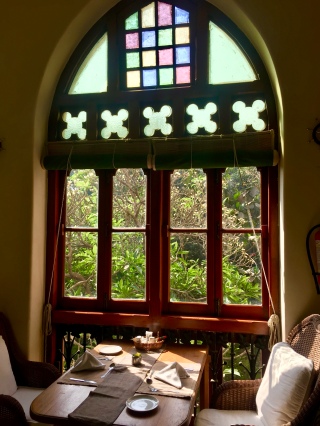
Although as it happens, while in Mumbai, I’ve taken to starting my day a bit differently. The fact is, the climate at this time of year is pretty intolerable to an English(wo)man. The temperature is 35 degrees or so, cooler than Delhi in fact, but the humidity is about 70%. One evening at dinner with a Mumbaikar, I remarked that it’s not surprising India has such a high heart attack rate given the amount of fat in which much Indian food is cooked. He rejoined that the real problem here is people don’t walk enough: and I’m beginning to see why that is. At this time of year, walking anywhere is a serious challenge after ten o’clock in the morning if you don’t want to be drenched in sweat (and later in the year, three months of monsoon rains can mean wading through flood water if you choose to go on two legs).
Added to that, Mumbai can be unpleasant to wander around because the noise pollution in this city is something to behold. I’ve taken to wearing ear plugs in order to protect my hearing from the constant barrage of honking. I genuinely do try to be tolerant of the many differences which India presents from Western Europe but this one is beginning to wear me out. In Mumbai, there is zero enforcement of “no honking” zones and all Indian drivers see it as their birthright to honk continuously: someone really needs to point out that using the vehicle’s wing and rear view mirrors would be a much less intrusive strategy! Anyway, it’s at its worst from nine to five, so since I arrived here I have been getting up and going out at six thirty, returning for breakfast at half ten. One morning I walked from Chowpatty Beach – one of the best known public beaches here – all the way down Marine Drive, relishing the early morning haze over the sea, the joggers, people doing yoga and the young couples looking out over the strand, before I turned off the seafront to come past the Oval Maidan: a huge public recreation space which is covered – even at half past seven in the morning – with young men playing cricket (in common with much of India: where British kids would be kicking a ball, here you learn from an early age to create a wicket out of just about anything). It’s at this time of day that Mumbai is at its most attractive – and then again in the early evening when the temperature drops (a bit) and people promenade on the beaches, meet friends and family and perform “puja” (worship). After a few days adjusting to this new routine, I’ve received the message Mumbai sends its visitors loud and clear: you’re very welcome but get on board and enjoy the ride because we don’t take any prisoners here.
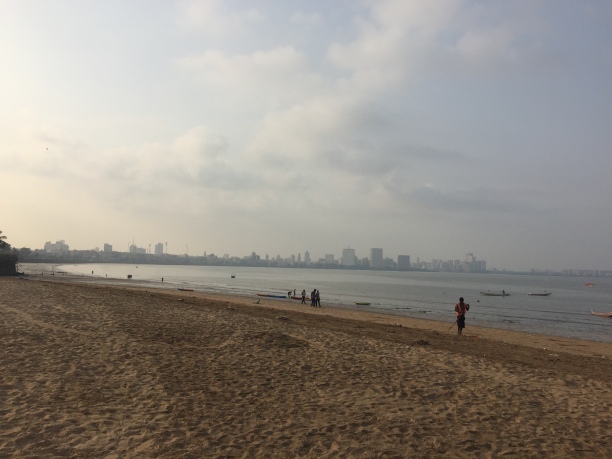
Footnote: The taxi I got from the airport was driven by a woman! I saw a sign for the “By Women, For Women” prepaid taxi service and had no hesitation in requesting one. The taxi company is one of several in Mumbai dedicated to female empowerment: my driver was a single parent of two, happy to be able to combine bread winning, with leaving her kids in the care of her local community, a favour she would return for other mothers when not on shift. Although there is still a very long way to go, generally my impression is of greater equality for women in the South of India than the North, and Mumbai seems less conservative too: for the first time since I got to India I’ve been wearing shorts, something I’ve completely avoided in Rajasthan, despite the heat, for fear of being conspicuous. #womanpower.
